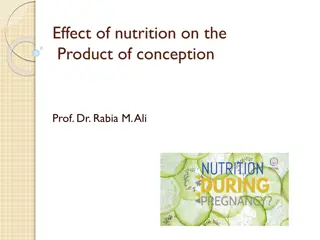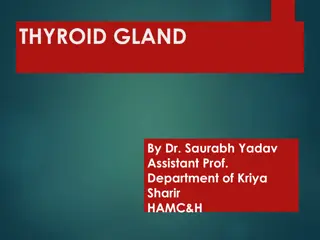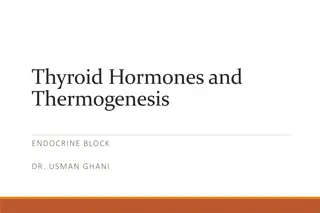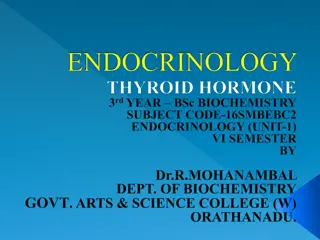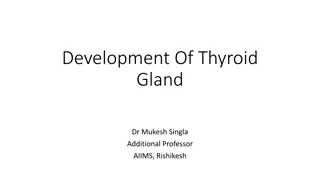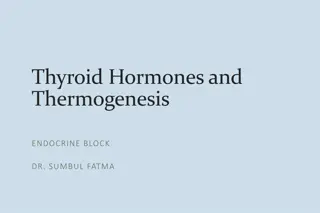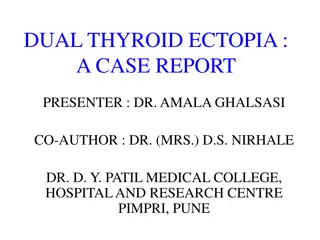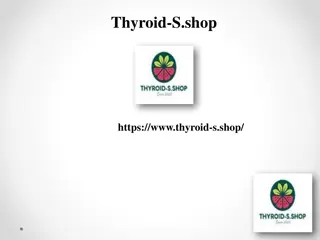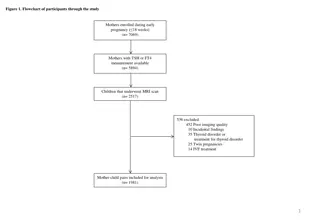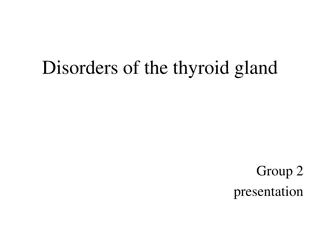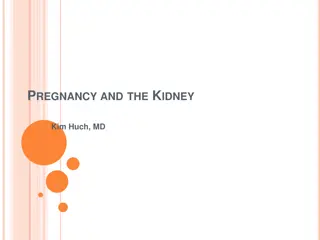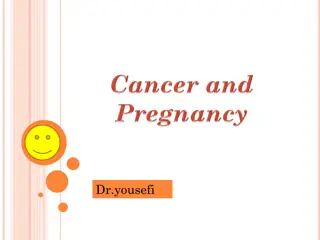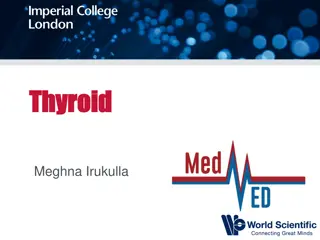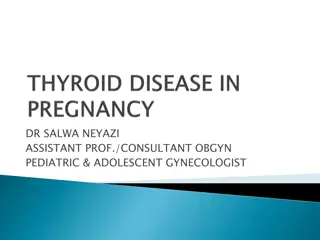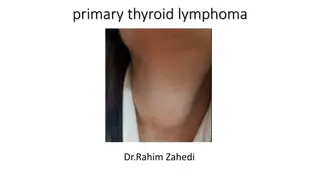
Optimal Diagnostic Strategy for Thyroid Nodules Detected During Pregnancy
Balancing the diagnosis and treatment of thyroid nodules and cancer during pregnancy is crucial, with a higher risk associated with certain patient histories. Utilizing ultrasound for accurate detection and monitoring is recommended, following established guidelines for management.
Uploaded on | 1 Views
Download Presentation

Please find below an Image/Link to download the presentation.
The content on the website is provided AS IS for your information and personal use only. It may not be sold, licensed, or shared on other websites without obtaining consent from the author. If you encounter any issues during the download, it is possible that the publisher has removed the file from their server.
You are allowed to download the files provided on this website for personal or commercial use, subject to the condition that they are used lawfully. All files are the property of their respective owners.
The content on the website is provided AS IS for your information and personal use only. It may not be sold, licensed, or shared on other websites without obtaining consent from the author.
E N D
Presentation Transcript
2017 Guidelines of the 2017 Guidelines of the American Thyroid Association American Thyroid Association for the Diagnosis and for the Diagnosis and Management of Thyroid Management of Thyroid Disease Disease during Pregnancy and the during Pregnancy and the Postpartum Postpartum
IX. Thyroid Nodules and Thyroid Cancer during Pregnancy Thyroid nodules and thyroid cancer discovered during pregnancy present unique challenges to both the clinician and the mother. A careful balance is required between making a definitive diagnosis and instituting treatment while avoiding interventions that may adversely impact the mother, the health of the fetus, or the maintenance of the pregnancy.
Increasing age is associated with an increase in the proportion of pregnant women who have thyroid nodules. A prevalence of thyroid cancer in pregnancy of 14.4/100,000 was reported, with papillary cancer being the most frequent pathological type. Timing of diagnosis of the thyroid malignancy was as follows: 3.3/100,000 cases diagnosed before delivery, 0.3/100,000 at delivery, and 10.8/100,000 within one year postpartum.
QUESTION 67 - WHAT IS THE OPTIMAL DIAGNOSTIC STRATEGY FOR THYROID NODULES DETECTED DURING PREGNANY?
History and physical examination The patient with a thyroid nodule should be asked about a family history of benign or malignant thyroid disease, familial medullary thyroid carcinoma, multiple endocrine neoplasia type 2 (MEN 2), familial papillary thyroid carcinoma, and a familial history of a tumor syndrome predisposing to thyroid cancer syndrome (e.g., Phosphatase and tensin homolog (PTEN) hamartoma tumor syndrome [Cowden s disease], familial adenomatous polyposis, Carney complex, or Werner syndrome). The malignancy risk is higher for nodules detected in both adult survivors of childhood cancers where treatment involved head/neck/cranial radiation and those exposed to ionizing radiation before 18 years of age . Thorough palpation of the thyroid and neck inspection for cervical nodes is essential.
Ultrasound Thyroid ultrasound is the most accurate tool for detecting thyroid nodules, determining their sonographic features and pattern, monitoring growth, and evaluating cervical lymph nodes. The recent 2015 American Thyroid Association Management Guidelines for Adult Patients with Thyroid Nodules and Differentiated Thyroid Cancer should be referenced for diagnostic use and performance of thyroid and neck sonography as well as for decision- making regarding fine needle aspiration (FNA) for thyroid nodules . Recent reports have validated that the identification of defined nodule sonographic patterns representing constellations of sonographic features is more robust for malignancy risk correlation than that associated with individual ultrasound characteristics . Hence, a high-suspicion sonographic pattern that includes solid hypoechoic nodules with irregular borders and microcalcifications correlates with a >70% chance of cancer compared to the very low suspicion pattern of a noncalcified mixed cystic solid or spongiform nodule (<3% cancer risk). The 2015 ATA guidelines (443, Recommendation 9) recommend different FNA size cut- offs based upon 5 defined sonographic patterns and their associated risk stratification for thyroid cancer (Table 9).
Thyroid function tests All women with a thyroid nodule should have a TSH performed. Thyroid function tests are usually normal in women with thyroid cancer. In non- pregnant women, a subnormal serum TSH level may indicate a functioning nodule, which is then evaluated with scintigraphy because functioning nodules are so rarely malignant that cytologic evaluation is not indicated. However, pregnancy produces two hurdles for following this algorithm. First, the lower limit of the TSH reference range decreases, especially during early gestation, making it difficult to differentiate what is normal for pregnancy from potential nodular autonomous function. Second, scintigraphy with either technetium pertechnetate or 123I is contraindicated in pregnancy.
Calcitonin and thyroglobulin As within the general population, the routine measurement of calcitonin remains,controversial . Calcitonin measurement may be performed in pregnant women with a family history of medullary thyroid carcinoma or multiple endocrine neoplasia 2 or a known RET gene mutation. However, the utility of measuring calcitonin in all pregnant women with thyroid nodules has not been evaluated. The pentagastrin stimulation test is contraindicated in pregnancy.
In the presence of an in situ thyroid gland, serum thyroglobulin measurements are neither sensitive nor specific for thyroid cancer and can be elevated in many benign thyroid disorders . Thus, serum thyroglobulin measurement is not recommended.
Fine Needle Aspiration Fine needle aspiration is a safe diagnostic tool in pregnancy and may be performed in any trimester. Pregnancy does not appear to alter a cytological diagnosis of thyroid tissue obtained by FNA, but there have been no prospective studies to evaluate potential differences in FNA cytology obtained during pregnancy versus in the nonpregnant state. Since overall survival does not differ if surgery is performed during or after gestation in patients diagnosed with thyroid cancer during pregnancy, patient preference for timing of FNA (during pregnancy or postpartum) should be considered.
Radionuclide scanning 131I readily crosses the placenta and the fetal thyroid begins to accumulate iodine by 12- 13 weeks gestation. There are reports of inadvertent administration of therapeutic131I therapy for treatment of hyperthyroidism during unsuspected pregnancy. If 131I is given after 12- 13 weeks gestation, it accumulates in the fetal thyroid resulting in fetal/neonatal hypothyroidism. In this scenario, The International Atomic Energy Agency (IAEA) recommends intervention with 60-130 mg of stable potassium iodide given to the mother only if the pregnancy is discovered within 12 hours of 131I administration. This will partially block the fetal thyroid, hence reducing fetal thyroid 131I uptake.
However, if maternal treatment occurs prior to 12 weeks, the fetal thyroid does not appear to be damaged. Rather, the issue is the fetal whole body radiation dose due to gamma emissions from 131I in the maternal bladder, which is in the range of 50-100 mGy/GBq of administered activity. This dose is decreased by hydrating the mother and by encouraging frequent voiding. No studies have specifically examined whether scanning doses of 123I or technetium pertechnetate have adverse fetal effects if used during gestation.
In general, these are contraindicated because all maternal radionuclides are associated with a fetal irradiation resulting from both placental transfer and external irradiation from maternal organs, specifically the bladder. Again, both maternal hydration and frequent voiding reduce fetal exposure. The optimal diagnostic strategy for thyroid nodules detected during pregnancy is based on risk stratification. All women should have the following: a complete history and clinical examination, serum TSH measurement, and ultrasound of the neck.
Recommendation 56 For women with suppressed serum TSH levels that persist beyond 16 weeks gestation, FNA of a clinically relevant thyroid nodule may be deferred until after pregnancy. At that time, if serum TSH remains suppressed, a radionuclide scan to evaluate nodule function can be performed if not breastfeeding. (Strong recommendation, Low quality evidence)
Recommendation 57 The utility of measuring calcitonin in pregnant women with thyroid nodules is unknown. The task force cannot recommend for or against routine measurement of serum calcitonin in pregnant women with thyroid nodules. (No recommendation, Insufficient evidence)
Recommendation 58 Thyroid nodule FNA is generally recommended for newly detected nodules in pregnant women with a non- suppressed TSH. Determination of which nodules require FNA should be based upon the nodule s sonographic pattern as outlined in Table 9. The timing of FNA, whether during gestation or early postpartum, may be influenced by the clinical assessment of cancer risk, or by patient preference. (Strong recommendation, Moderate quality evidence)
Recommendation 59 Radionuclide scintigraphy or radioiodine uptake determination should not be performed during pregnancy. (Strong recommendation, High quality evidence)
QUESTION 70 - HOW SHOULD CYTOLOGICALLY BENIGN THYROID NODULES BE MANAGED DURING PREGNANCY? Although pregnancy is a risk factor for modest progression of nodular thyroid disease, there is no evidence demonstrating that levothyroxine is effective in decreasing the size or arresting the growth of thyroid nodules during pregnancy. Hence, levothyroxine suppressive therapy for thyroid nodules is not recommended during pregnancy. Nodules that were benign on FNA but show rapid growth or US changes suspicious for malignancy should be evaluated with a repeat FNA and be considered for surgical intervention. In the absence of rapid growth, nodules with biopsies which are either benign do not require surgery during pregnancy.
Recommendation 60 Pregnant women with cytologically benign thyroid nodules do not require special surveillance strategies during pregnancy, and should be managed according to the 2015 ATA Management Guidelines for Adult Patients with Thyroid Nodules and Differentiated Thyroid Cancer. (Strong recommendation, Moderate quality evidence)
QUESTION 71 - HOW SHOULD CYTOLOGICALLY INTDETERMINATE NODULES BE MANAGED DURING PREGNANCY? There have been no prospective studies evaluating the outcome and prognosis of women with an FNA that is interpreted as either atypia of undetermined significance/follicular lesion of undetermined significance (AUS/FLUS), suspicious for follicular neoplasm (SFN), or suspicious for malignancy (SUSP). The reported malignancy rates associated with these cytologic diagnoses range from 6-48% for AUS/FLUS, 14- 34% for SFN and 53-87% for SUSP.
Although molecular testing for cytologically indeterminate nodules is now being considered, no validation studies address application of these tests in pregnant women. It is theoretically possible that thyroid gestational stimulation may alter a nodule s gene expression and change diagnostic performance of molecular tests based upon RNA expression, whereas testing based upon either single base pair DNA mutations or translocations would be less likely to be affected.
Since prognosis for differentiated thyroid cancer diagnosed during pregnancy is not adversely impacted by performing surgery postpartum, it is reasonable to defer surgery until following delivery. As the majority of these women will have benign nodules, levothyroxine therapy during pregnancy is not recommended.
Recommendation 61 Pregnant women with cytologically indeterminate (AUS/FLUS, SFN, or SUSP) nodules, in the absence of cytologically malignant lymph nodes or other signs of metastatic disease, do not routinely require surgery while pregnant. (Strong recommendation, Moderate quality evidence)
Recommendation 62 During pregnancy, if there is clinical suspicion of an aggressive behavior in cytologically indeterminate nodules, surgery may be considered. (Weak recommendation, Low quality evidence)
Recommendation 63 Molecular testing is not recommended for evaluation of cytologically indeterminate nodules during pregnancy. (Strong recommendation, Low quality evidence)
QUESTION 72 - HOW SHOULD NEWLY DIAGNOSED THYROID CARCINOMA BE MANAGED DURING PREGNANCY?
The 2015 ATA guidelines recommend that a nodule with cytology indicating papillary thyroid carcinoma discovered early in pregnancy should be monitored sonographically and, if either it grows substantially by 24 weeks gestation (50% in volume and 20% in diameter in two dimensions), or if metastatic cervical lymph nodes are present, surgery should be considered in the second trimester. However, if it remains stable by midgestation, or if it is diagnosed in the second half of pregnancy, surgery may be performed after delivery. Surgery in the second trimester is an option if the differentiated thyroid cancer is advanced stage at diagnosis or if the cytology indicates medullary or anaplastic carcinoma.
If surgery is not performed, the utility of thyroid hormone therapy targeted to lower serum TSH levels to improve the prognosis of differentiated thyroid cancer diagnosed during gestation is not known. Because higher serum TSH levels may be correlated with a more advanced stage of cancer at surgery, if the patient s serum TSH is >2 mU/L, it may be reasonable to initiate thyroid hormone therapy to maintain the TSH between 0.3 to 2.0 mU/L for the remainder of gestation.
Recommendation 64 PTC detected in early pregnancy should be monitored sonographically. If it grows substantially before 24-26 weeks gestation, or if cytologically malignant cervical lymph nodes are present, surgery should be considered during pregnancy. However, if the disease remains stable by midgestation, or if it is diagnosed in the second half of pregnancy, surgery may be deferred until after delivery. (Weak recommendation, Low quality evidence)
Recommendation 65 The impact of pregnancy on women with newly diagnosed medullary carcinoma or anaplastic cancer is unknown. However, a delay in treatment is likely to adversely impact outcome. Therefore, surgery should be strongly considered, following assessment of all clinical factors. (Strong recommendation, Low quality evidence)
QUESTION 73 - WHAT ARE THE TSH GOALS FOR PREGNANT WOMEN WITH PREVIOUSLY TREATED THYROID CANCER RECEIVING LEVOTHYROXINE THERAPY?
Based on studies which have demonstrated a lack of maternal or neonatal complications from subclinical hyperthyroidism, it is reasonable to assume that the pre-conception degree of TSH suppression can be safely maintained throughout pregnancy. The appropriate level of TSH suppression depends upon pre-conception risk of residual or recurrent disease. According to the 2009 and 2015 ATA management guidelines for DTC, and the European Thyroid Association (ETA) consensus, the serum TSH should be maintained indefinitely below 0.1 mU/L in patients with persistent structural disease.
Hence, for a patient at initial high risk for recurrence, TSH suppression at or below 0.1 mU/L is recommended. If the patient then demonstrates an excellent response to therapy at one year with an undetectable suppressed serum Tg and negative imaging, the TSH target may rise to the lower half of the reference range.
The main challenge in caring for women with previously treated DTC is maintaining the TSH level within the pre- conception range. Patients require careful monitoring of thyroid function tests in order to avoid hypothyroidism.
Thyroid function should be evaluated as soon as pregnancy is confirmed. The adequacy of LT4 treatment should be checked four weeks after any LT4 dose change. The same laboratory should be utilized to monitor TSH and thyroglobulin levels before, during, and after pregnancy.
Recommendation 66 Pregnant women with thyroid cancer should be managed at the same TSH goal as determined pre-conception. TSH should be monitored approximately every 4 weeks until 16-20 weeks of gestation, and at least once between 26-32 weeks of gestation. (Strong recommendation, Moderate quality evidence)
QUESTION 74 - WHAT IS THE EFFECT OF THERAPEUTIC RADIOACTIVE IODINE TREATMENT ON SUBSEQUENT PREGNANCIES?
Following surgery for DTC, many patients will receive an ablative dose of radioactive iodine. The possible deleterious effect of radiation on gonadal function and the outcome of subsequent pregnancies has been evaluated by Sawka et al. and Garsi et al. (the latter collected 2673 pregnancies, 483 of which occurred after RAI treatment). Neither study found an increased risk of infertility, pregnancy loss, stillbirths, neonatal mortality, congenital malformations, pre-term births, low birth weight, or death during the first year of life, or cancers in offspring.
Radioiodine (RAI) treatment may lead to suboptimal thyroid hormonal control during the month following administration. It therefore seems reasonable to wait a minimum of 6 months to ensure that thyroid hormonal control is stable before conceiving following RAI ablative therapy.
131I may affect spermatogenesis. In one study following men after 131I therapy, there was a dose- dependent increase in FSH levels and a reduction in normokinetic sperm. Therefore, it seems prudent for a man who has received 131I to wait 120 days (the lifespan of sperm) after 131I therapy before attempting to conceive.
Recommendation 67 Pregnancy should be deferred for 6 months after a woman has received therapeutic radioactive iodine (131I) treatment. (Strong recommendation, Low quality evidence)
QUESTION 75 - WHAT IS THE EFFECT OF TYROSINE KINASE INHIBITORS ON PREGNANCY?
Several tyrosine kinase inhibitor medications are now FDA- approved for the therapy of metastatic differentiated and medullary thyroid cancer. These include sorafenib, lenvatinib, and cabozantinib. All three drugs have demonstrated both teratogenicity and embryo toxicity in animals when administered at doses below the recommended human dose. There are no human studies. The FDA recommends that women be advised of the TKI potential risk to the fetus. However, specific advisories vary by medication.
Furthermore, the use of any TKI must be guided by an assessment of risks to benefits that is also impacted by the stage of disease and recommended drug indications. For sorafenib, the FDA prescribing information counsels to avoid pregnancy while taking the drug. For lenvatinib, contraception is explicitly recommended. For cabozantinib, no additional warnings are listed.
QUESTION 76 - DOES PREGNANCY INCREASE THE RISK OF DTC RECURRENCE?
Thus, pregnancy does not pose a risk for tumor recurrence in women without structural or biochemical disease present prior to the pregnancy. Therefore, women with an excellent response to therapy as defined by the 2015 ATA guidelines do not require additional monitoring during gestation. However, pregnancy may represent a stimulus to thyroid cancer growth in patients with known structural (ATA 2015 structural incomplete response to therapy) or biochemical (ATA 2015 biochemical incomplete response to therapy) disease present at the time of conception, and requires monitoring.
QUESTION 77 - WHAT TYPE OF MONITORING SHOULD BE PERFORMED DURING PREGNANCY IN A PATIENT WHO HAS ALREADY BEEN TREATED FOR DTC PRIOR TO PREGNANCY?
Recommendation 68 Ultrasound and thyroglobulin monitoring during pregnancy is not required in women with a history of previously treated differentiated thyroid carcinoma with undetectable serum thyroglobulin levels (in the absence of Tg autoantibodies) classified as having no biochemical or structural evidence of disease prior to pregnancy. (Strong recommendation, Moderate quality evidence)


